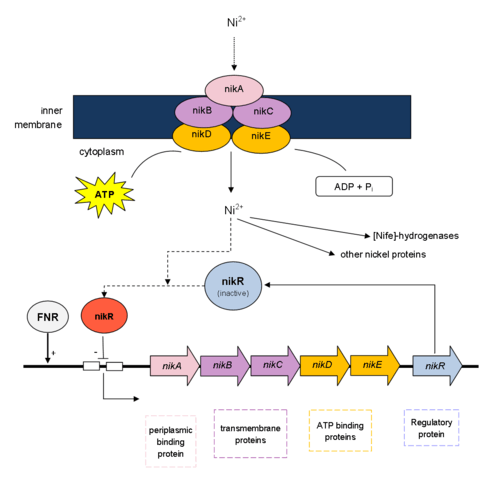Nik operon
The nik operon is an operon required for uptake of nickel ions into the cell. It is present in many bacteria, but has been extensively studied in Helicobacter pylori. Nickel is an essential nutrient for many microorganisms, where it participates in a variety of cellular processes. However, excessive levels of nickel ions in cell can be fatal to the cell. Nickel ion concentration in the cell is regulated through the nik operon.
Structure of the nik operon
The nik operon consists of six genes. The first five genes nikABCDE encode components of a typical ABC transport system and the last gene nikR encodes a DNA-binding protein that represses transcription of nikABCDE when sufficient Ni2+ is present. The nikR gene is located 5 bp downstream of the end of nikE, transcribed in the same direction as nikABCDE. The following table summarizes the structure of the nik operon:
| Gene | Protein encoded | Functional Role |
|---|---|---|
| nikA | ABC transporter Ni2+binding component | binds Ni2+ in the periplasm and transfers it to the permease; may also play a role in chemotaxis away from toxic concentrations of nickel |
| nikB & nikC | ABC transporter permease components | transport of Ni2++ across the inner membrane |
| nikD & nikE | ABC transporter ATP-binding components | hydrolyzes ATP to provide energy for the transport process |
| nikR | transcriptional regulator of the nikABCDE operon | downregulates expression of the nik operon in the presence of excess Ni2+ ions |
Regulation
nikR Regulation
Regulation of expression of the nikR gene is achieved by two promoters. The first is through the FNR regulon. The FNR controlled regulation of nikABCDE–nikR occurs at a FNR box located upstream of nikA at a putative NikR binding site.[1] The second promoter element regulating nikR expression occurs 51 bp upstream of the nikR transcription start site and results in low-level constitutive expression. There is also evidence that nikR expression is partially autoregulated.[2]
Regulation of Ni2+ uptake
Ni2+ is taken up into prokaryotic cells by one of two types of high-affinity transport systems.[3] The first method involves ABC-type transporters (discussed in this article) and the second mechanism makes use of transition-metal permeases (such as HoxN of Ralstonia eutropha). The ABC-type transporter system consists of five proteins, NikA–E, that carry out the ATP-dependent transport of Ni2+.[1] NikA is a soluble, periplasmic, Ni-binding protein; NikB and NikC form a transmembrane pore for passage of Ni; and NikD and NikE hydrolyze ATP and couple this energy to Ni2+-transport. When Ni2+ is available in excess, NikR protein represses transcription of nikABCDE.[2]

Repression by NikR binding
Using profile-based sequence database searches, NikR was shown to be a member of the ribbon-helix-helix (RHH) family of transcription factors.[4] It has been demonstrated that the N-terminal domain of NikR is responsible for binding to DNA and that it only binds in presence of Ni2+. NikR has two sites for binding to Ni2+ ions. Binding of Ni2+ at concentrations that allow full occupancy of only the high-affinity sites is sufficient for operator binding, but the affinity for the operator is increased 1000-fold and the operator footprints are larger when both nickel-binding sites are occupied.[5] These results, combined with estimates of intracellular Ni2+ and NikR concentrations, lead to the conclusion that NikR is able to sense Ni2+ and regulate the nik operon expression over a range of intracellular Ni2+ concentrations from as low as one to as high as 10,000 molecules per cell.
See also
- gene regulation
- Operon
- lac operon
References
- Navarro, Clarisse; Wu, Long-Fei; Mandrand-Berthelot, Marie-Andrée (1 September 1993). "The nik operon of Escherichia coli encodes a periplasmic binding-protein-dependent transport system for nickel". Molecular Microbiology. 9 (6): 1181–1191. doi:10.1111/j.1365-2958.1993.tb01247.x.
- De Pina, K; Desjardin, V; Mandrand-Berthelot, MA; Giordano, G; Wu, LF (January 1999). "Isolation and characterization of the nikR gene encoding a nickel-responsive regulator in Escherichia coli". Journal of Bacteriology. 181 (2): 670–4. PMC 93426. PMID 9882686.
- Eitinger, T; Mandrand-Berthelot, MA (January 2000). "Nickel transport systems in microorganisms". Archives of Microbiology. 173 (1): 1–9. doi:10.1007/s002030050001. PMID 10648098.
- Chivers, PT; Sauer, RT (Jun 30, 2000). "Regulation of high affinity nickel uptake in bacteria. Ni2+-Dependent interaction of NikR with wild-type and mutant operator sites". The Journal of Biological Chemistry. 275 (26): 19735–41. doi:10.1074/jbc.m002232200. PMID 10787413.
- Chivers, Peter T.; Sauer, Robert T. (1 October 2002). "NikR Repressor". Chemistry & Biology. 9 (10): 1141–1148. doi:10.1016/s1074-5521(02)00241-7.